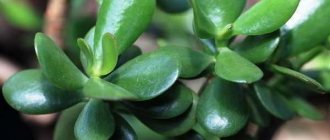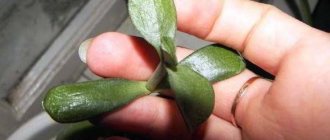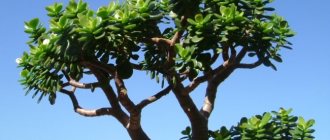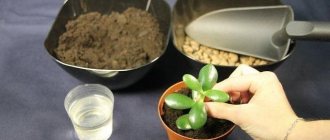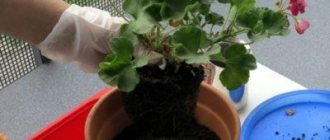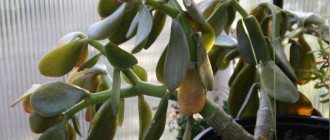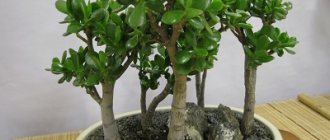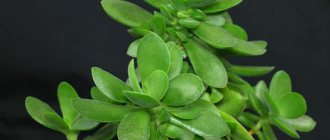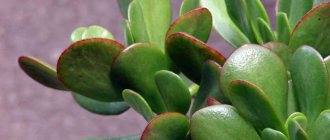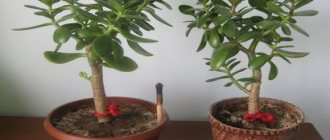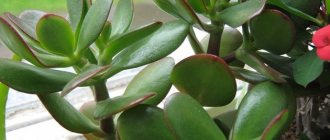Why did the money tree wither?
The money tree belongs to the group of succulents, so it needs rare but sufficient watering. Therefore, the money tree often begins to wither due to insufficient water. But the tree cannot tolerate excess moisture, so if you water the plant too often or give it large volumes of water, its leaves will begin to wither.
This is due to the fact that the root system of the plant is very weak and is located under the soil surface. With excessive watering, the tender roots begin to rot, as a result of which the plant ceases to receive nutrients. In this case, its leaves wither, begin to turn yellow, and fall off.
It is very important to water the plant correctly, carrying out the procedure in a timely manner and using small volumes of water.
When the roots rot, fusarium rot may appear or an infection may develop, which often leads to the death of the plant. Another reason why the leaves of the Crassula plant wither may be the insufficient volume of the pot.
It is necessary to replant a young plant every year in the spring, purchasing a pot of larger size and volume. If the roots become too crowded in the pot, the plant's leaves will wilt and may begin to fall off.
It is also necessary to pay attention to the temperature in the room.
If the fat woman is too cold or, conversely, very hot, this will also lead to problems. In this case, the tree’s leaves and trunk wither, it loses its attractive appearance and begins to hurt.
Often, the money tree's leaves wither due to a lack of light. The Crassula comes from Africa, so it loves the sun very much, but is afraid of direct sunlight, especially passing through windows.
For this reason, it is necessary to place the plant in a very sunny place , but next to a window, and not on the windowsill. If the tree is too dark, its shoots stretch out and its leaves wither. With excessive lighting, or more precisely, when placing a tree in direct sunlight, its leaves not only wither, but also burns appear on their surface.
Crassula leaves can also wilt due to stress. The plant does not like rearrangements, so it must be placed immediately in a permanent place. Moving it to another room will stress the plant and cause its leaves to wilt.
Stress can also be caused by watering with cold water, drafts, or being without water for a long time.
Sometimes the leaves wither due to contamination, so every month the fat plant must be washed in the shower, but so that water does not get into the pot. The young plant can be tilted over a sink or bathtub and washed with gentle streams of warm water.
An adult plant should be placed in a bathtub, wrapping the pot with plastic film to prevent water from getting into the soil. The leaves of the money tree also wither when there is a lack of nutrients in the soil, so once a month it is necessary to feed the plant with special fertilizers for cacti.
How to understand that Crassula has rotted?
Fungi or bacteria are to blame for money tree rotting. Roots and trunks most often rot, but branches, leaves and fruits can also rot. The process of decay is noticed by a change in the appearance of the plant.
Roots
Yellowing and wilting of leaves are the first signs of root rot. When rotting, the root hairs dry out, and the rhizome becomes soft and gray-brown in color.
To inspect the plant, it is removed from the container. Some of the roots will remain in the pot with soil; they will be slimy and have an unpleasant odor. With severe damage, the outer layers of the stem and roots peel off, and the central and lateral roots turn brown and begin to rot.
Trunk
When the trunk rots, the leaves wrinkle or become soft, stickiness appears at the base of the stem, the trunk bends or stretches, and all this is accompanied by an unpleasant odor.
Leaf sluggishness due to pests
Very often, the appearance of pests and diseases causes the fat plant to wither. In most cases, the money tree is affected by:
- Shchitovka. In this case, yellowish-brown or brown spots are observed on the leaves and surface of the trunk, rising above the general level. Adult parasites can be removed from the plant by hand, after which it is necessary to treat the entire plant with a soap solution. In this case, the leaves wither because scale insects suck the juice out of them. If there are a lot of parasites on the plant, it must be treated with an insecticide;
- Spider mite. A sign of damage is the presence of cobwebs on the branches of the tree and small yellow spots on the surface of the leaves. When this pest appears, the leaves of the Crassula wither and begin to fall off. To eliminate the parasite, it is necessary to treat the plant with an insecticide;
- Mealybug. At the same time, a white coating similar to cotton wool appears in the axils of the leaves. The leaves also actively wither, as the parasite sucks the juice out of the plant. Pests can be collected manually, after which the Crassula can be treated with a solution of laundry soap or an insecticide;
- Aphids. When aphids appear, the leaves of the plant begin to quickly and actively wither, especially when there are a large number of pests. In such a situation, the entire above-ground part of the fat plant should be sprayed with an infusion of onion peels with the addition of laundry soap or an insecticide.
If the plant is affected by diseases, it is necessary to use appropriate drugs to eliminate them.
How to deal with diseases and pests?
Despite the fact that the Crassula is a tree with good immunity, and it is not susceptible to serious diseases, sooner or later certain ailments can affect it. Thus, in conditions of too high air or soil humidity, as well as high ambient temperature, pathogenic microorganisms - dangerous fungi - can penetrate into the roots of the plant. It can attack the vital components of the money tree. In addition, these ailments can effectively hide under the guise of rot. It can be gray or green rot.
Once sick, the tree literally withers before our eyes. Its leaves inevitably begin to dry out and then simply fall off. Bacterial damage to a plant begins from the moment the tree itself begins to actively wither, and the leaves become covered with a brown coating and then fall off. Overcoming pathogenic bacteria is not as easy as it might seem. Very often it is not possible to treat the plant here and you simply have to get rid of the tree.
Fungal diseases always search for young tissues of green organisms. Actively spreading, they can lead to the crown of the tree becoming bare, and then it will die altogether. In this case, the plant needs to be revived as soon as possible.
One of the most common parasites that “love” to infect the money tree is the mealybug. Gradually, it can infect the entire plant, leaving light spots on the leaves that look like cobwebs. No less dangerous for this succulent are spider mites and scale insects.
A flower affected by these parasites begins to steadily lose its foliage, after which it becomes very lethargic and lifeless. It is possible to save it in such cases by resorting to treatment with specialized drugs. But you should act as quickly as possible.
You can fight the parasites that have infested the money tree using these proven methods.
- The scale is usually washed off by treating the foliage with a soap solution. Instead, it is permissible to destroy the harmful parasite with an insecticidal agent, for example, Aktara.
- To overcome the harmful spider mite, you must remove from the plant those leaves that it managed to infect. After this, the succulent is washed in the shower. After drying, the wood must be disinfected using Actellik.
- If the plant encounters a mealybug, it will need to be thoroughly treated with a special insecticide. After this, the fat plant can be transplanted into a new pot with new soil.
Another dangerous parasite can settle on the roots of the fat plant - the root mealybug. It's not so easy to spot him there. As a rule, such problems arise during the spring transplantation of the tree into a new pot and soil.
Next, it is recommended to carefully process the bunch of roots using Fufanon or Actellik.
It also happens that due to unregulated watering, the foliage of the money tree becomes too soft. If the soil in the pot has already dried out, but the situation has not changed, then this means that there is no way to do without replanting. The roots will definitely need to be freed from rot, washed in a solution of potassium permanganate, and then planted in new soil.
A bad sign is the appearance of black spots on the foliage of the money tree. As a rule, such damage makes itself felt if the plant has been sunburned or suffers from a dangerous fungal infection. In such a situation, it is advisable to move the tree to the shade, where the sun’s rays cannot reach it, and also treat it with Fundazol. It is advisable to stop watering for now and give the plant an influx of fresh air.
As soon as you notice that the plant has become a victim of parasites, the influence of which leads to serious diseases, you need to act quickly. Don't waste time. The longer a flower is attacked by pests, the faster it will die. It is not always possible to revive neglected trees.
What to do if money tree leaves wither and dry out
If the money tree has withered, first you need to accurately determine the cause. If the problem is related to rotting of the root system, then the plant requires an urgent transplant. To do this, the earthen lump must be carefully removed from the pot and placed in a container of water to remove soil from the roots.
After this, the damaged root system should be carefully examined and rotting areas should be removed with a sharp knife, powdering the wounds with crushed activated carbon.
Next, you should take a new pot of a suitable size, pour drainage and fresh soil into it and carefully plant the fat plant, watering it with a small amount of water. If there are pests or diseases, the plant must be improved by using folk remedies or store-bought preparations for treatment against parasites and infectious lesions.
If the reason for the wilting of the leaves is poor soil, the fat plant needs to be fed by properly diluting fertilizer for cacti, according to the instructions attached to the preparations. In summer, feeding is carried out once a month, and in winter once every two months, and the solution is used in half concentration.
If burns appear on the leaves, the plant must be moved to another place where there will be bright sunlight, but without direct sunlight, or the fat plant must be screened with a light tulle curtain. If the leaves wither because the plant does not have enough light, and its shoots stretch out, it is necessary to move it to a more illuminated place.
It is necessary to protect the plant from drafts, therefore, when choosing a permanent place, you should take into account the presence of windows and doors in the room, as well as the direction of air flow when ventilating.
A very important point is maintaining cleanliness in the room where the fat woman is located. The plant may wilt due to a large accumulation of dust in the room or due to insufficient space if the room is cluttered.
Crassula diseases
The fat woman rarely gets sick. This usually occurs due to improper watering or excessive lighting.
Table: why Crassula gets sick
| Disease | Cause | Prevention | Treatment |
| Mold in the bowl | High humidity, excessive watering. | Humidity control, adjusted irrigation regime. | Change of soil. Remove the plant from the bowl, clean the roots from the soil, rinse, and place in a new substrate. |
| Powdery mildew |
|
|
|
| Sooty fungus (niello) |
|
|
|
| Gray rot |
|
|
|
| Anthracnose |
|
| Treatment with Previkur, Skor, Fundazol (according to instructions). |
| Root and stem rot |
|
If the stem rots, the fat plant cannot be saved. |
Photo gallery: common money tree diseases
Table: how to save the fat plant from pests
| Pest | Description | Struggle |
| Shchitovka | Reaches a length of 5 mm, the body is covered with a waxy coating - a scute, and feeds on plant sap. The female lives for several months and lays eggs. |
|
| Spider mite | A very small insect (no more than 1 mm) is brown in color, loves dry air and high temperatures, attacks succulent leaves, feeds on their juice, weaves a web that prevents the plant from functioning normally. The fat woman gets sick and may die. |
|
| Mealybug | An insect up to 7 mm long with an oval body covered with a white coating like flour. It feeds on plant sap. The waste product is white mucus, which clogs the stomata on the leaves and interferes with the respiration process. |
|
Features of caring for a fat woman
In order for the plant to feel great, be healthy and beautiful, so that its leaves are densely arranged, large in size and have the correct shape and thickness, it must be conscientiously cared for and maintained in optimal living conditions.
Wilting leaves usually indicate that something is wrong and the Crassula needs help.
It is important to provide the plant with proper and complete lighting by placing it near a window on the southwest side, shielding it from direct sun with a tulle curtain. In winter, the fat plant may require lighting.
The correct temperature must also be maintained . In summer, its limits are about 23 - 27°C; if it rises higher, the plant may overheat, which will not benefit it at all. In winter, it is recommended to maintain the temperature within 18 – 20°C, and also ensure that it does not fall below +15°C.
The plant should be watered once a week with a small amount of warm water , replacing watering once a month with fertilizers diluted in water. In winter, watering should be reduced to once every 2 weeks, and fertilizers should be applied once every 2 months.
Preventive actions
For the health of the fat plant, it is recommended to strictly adhere to the watering regime. Do not place the indoor plant in strong sun, cold, or water it with too cold water. Also regularly feed the flower during the warm season.
- Set aside tap water.
- Wipe the leaves of the tree or spray from a spray bottle.
- Watch the lighting (it shouldn't be too dark or sunny).
- Change flower pots as the money tree grows.
- Periodically inspect the plant and feel its trunk.
If the plant has grown too much, change the pot. After transplantation, do not rush to feed with various preparations. This can be done only after 3-4 months. Treat a sick plant first and then feed it.
There should also be no one-sided lighting, drafts or a hot radiator nearby. In spring, do not rush to take the flowerpot out onto the balcony, as the tree may die at low temperatures.
The optimal temperature for the fat woman is about 21-30 degrees Celsius. In hot weather it grows stronger, the trunk and leaves become strong and saturated with moisture.
